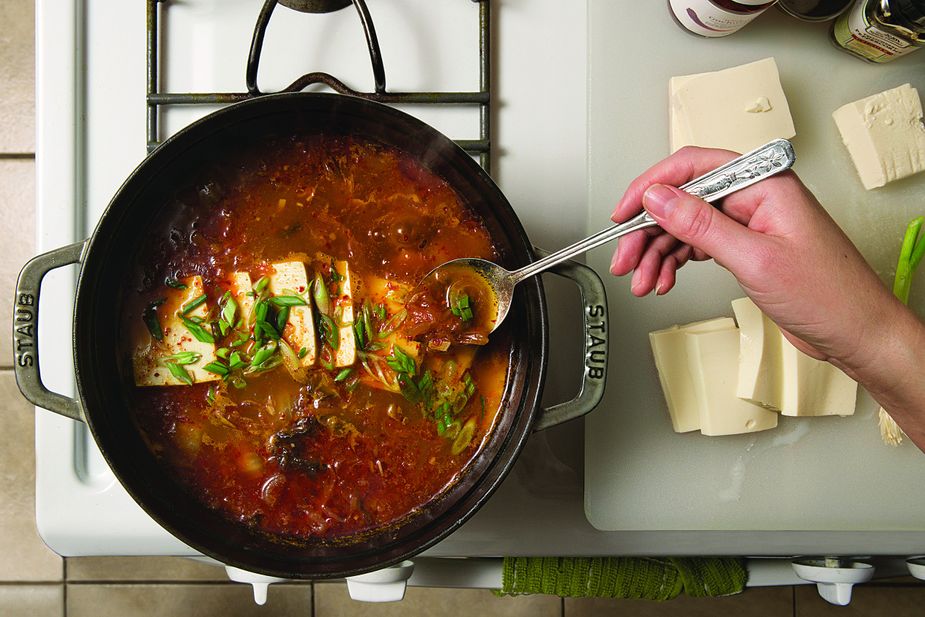Seoul Food
Published June 2020
By Becky Carman | 7 min read
Years ago, a friend of mine went to a Korean restaurant for the first time and reported back to me, “I know what to expect from Chinese or Japanese food, but Korean food—it might as well be from the moon.” My mom is Korean, I was born in Seoul, and I grew up with as much Korean food as American food. Though I don’t flinch at whole-animal meat preparations, boiling broth bright orange with chili, or months-old homemade ferments, the “What is this?”/ “Just eat it!” exchange between my mom and I happened often growing up. So there was probably some truth to my friend’s revelation.
Most Korean fare is not subtle. The cuisine is rooted in geography and history, with the terrain and weather of the Koreas requiring preservation of fresh foods so they’d last through winter. Many popular Korean dishes are the result of salting, drying, or long fermentations. Rice is the center of a traditional Korean meal, accompanied by banchan, or side dishes. The most iconic and important of all of these is Korea’s national dish, kimchi.

Becky Carman prepared Ben Alexander’s stew using tofu and her own homemade kimchi. Photo by John Jernigan
There are countless varieties of kimchi, the most familiar being Napa cabbage or tongbaechu kimchi. It’s high in both spice and funk, and ingredients beyond cabbage include salt, garlic, ginger, onion, Korean chile flakes known as gochugaru, and a seafood element—fish sauce, salted shrimp, even raw oysters. All the non-cabbage ingredients are combined into a paste and spread onto the leaves, after which the cabbage is left to ferment. Pre-technology, it was made by placing the kimchi in an earthenware crock called an onggi and burying it underground through the winter. However, it’s now common for Korean households to have a refrigerator specifically designed to keep kimchi at its prime. Kimchi can stay in the fridge for months, and it will still be edible, though it gets sourer, softer, fizzier, and—critically—smellier the longer you keep it. At its core, making kimchi requires you to, as chef Ben Alexander puts it, “let science do its thing.”
Alexander is the vice president of culinary operations of the Tulsa-based McNellie’s Group. He was born in Incheon, South Korea, and adopted at age two along with his two sisters by American parents. He says his parents emphasized the importance of keeping in touch with their roots, and Korean food was one way they did that.
“As a kid, I used to put kimchi in my packaged ramen noodle soup all the time,” Alexander says.
Like Alexander, my idea of Korean food is a hybrid of childhood memory, research, and personal taste, and I sense that, especially for Korean-Americans, the balance varies widely.
“There are some things that I’ll probably never change, like my kimchi recipe,” Alexander says. “But I just kind of cook what I feel is going to taste good. What I think is traditional could be completely different from you, so I try to stay away from traditional as much as possible.”
Alexander’s career was well underway before he started making Korean food, which he’s been doing for the last eight years or so. Roughly in that same span of time, I’ve watched in disbelief as Korean ingredients became trendy, then commonplace. You can get gochujang, a fermented Korean chile paste, at an average supermarket. Kimchi’s been ahead of the probiotics trend for thousands of years. The door is wide open now to incorporate elemental Korean flavors into anything, and kimchi is a good place to start.
“I’ll sit down and eat a bowl of rice and kimchi with some green onions on top like nobody’s business,” Alexander says. “But I’ve also made kimchi cornbread, put it in a burger, or just eaten it like it’s a pickle.”
Alexander notes the McNellie’s Group may incorporate more Korean flavors into the next menu update at Tulsa’s Yokozuna, including a possible kimchi fried rice. Until then, pick up a jar at any Asian market and many grocery store chains. If you’ve got a few spare hours, glass jars, and a refrigerator, you can even make your own—no backyard digging or travel to the moon required.
Not Your Traditional Kimchi and Pork Stew
By Ben Alexander
½ lb. Prairie Creek Farms pork belly
2 cups kimchi roughly chopped (really ripe preferred)
½ yellow onion, small, diced
1 Tbsp. minced garlic
1 Tbsp. minced ginger
Tofu and/or Korean rice cakes (optional)
For the broth:
2 Tbsp. gochugaru (Korean chile flake)
2 tsp. gochujang (Korean chile paste)
2 Tbsp. soy sauce
¼ tsp. black pepper
4 cups pork or chicken stock
Directions:
Heat a large pot and add a neutral oil like canola or soybean. When the oil starts smoking, add cubed pork belly and brown on all sides. Once browned and when the fat has rendered slightly, add onions and cook on medium to low heat until the onions are translucent. Add the garlic, ginger, and kimchi, and cook for about 3 or 4 minutes. Add the broth ingredients, and bring to a boil. When it comes to a boil, turn to low heat and simmer for 30 minutes, adding water up to the original level if needed. Season with salt and pepper to taste. Best enjoyed with a fresh pot of hot rice.







